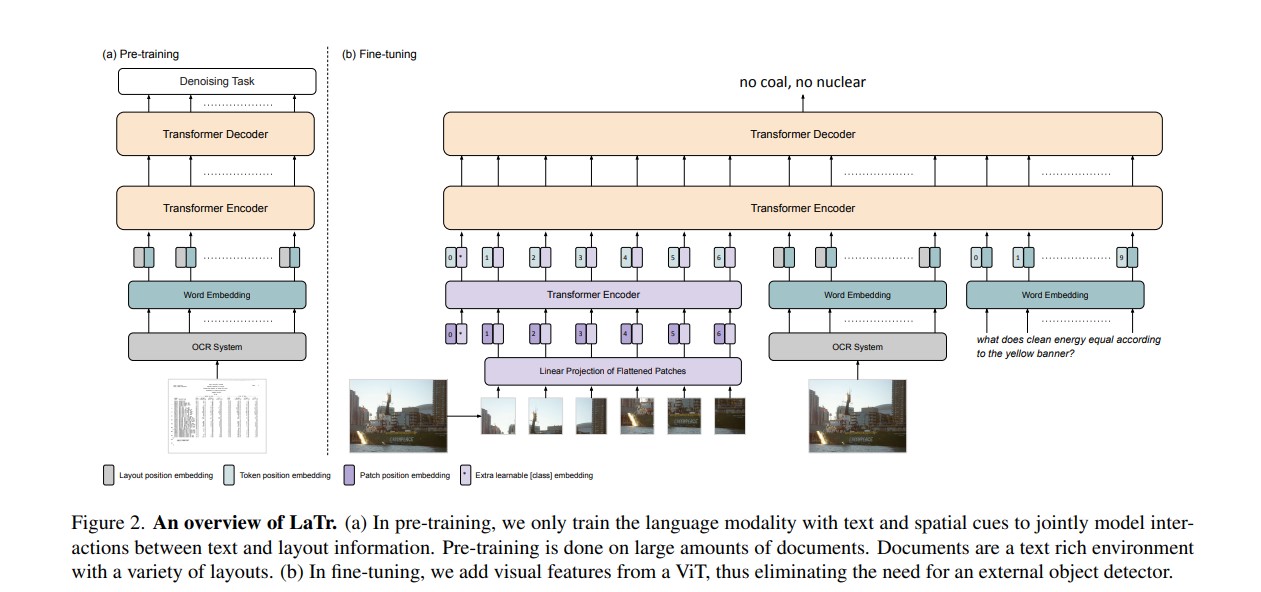Implementation of LaTr: Layout-aware transformer for scene-text VQA,a novel multimodal architecture for Scene Text Visual Question Answering (STVQA).
LaTr improves robustness towards OCR errors, a common reason for failure cases in STVQA. In addition, by leveraging a vision transformer, LaTr eliminate the need for an external object detector. LaTr outperforms state-of-the-art STVQA methods on multiple datasets. In particular, +7.6% on TextVQA, +10.8% on ST-VQA and +4.0% on OCR-VQA (all absolute accuracy numbers).
The official implementation was not released by the authors.
NOTE: I have tried my best to implement this paper, and have taken minimum assumptions while implementing, but, one of the essential part of any implementation is to provide pre-trained weights and show the results of your implementation on the dataset mentioned in the paper, however due to resource limitation from my side, I won't be able to provide pre-trained weights. However, I would try to include scripts in the example, so that if someone has the resources, they can use the scripts to obtain pre-trained weights and share it. Open to all feedbacks, and hope this implementation turns out to be useful to the community.
An interactive demo for the same can be found out here
pip install transformers
pip install sentencepiece==0.1.91
pip install pytesseract
sudo apt install tesseract-ocr
pip install 'Pillow==7.1.2'- For pre-training task: Refer here
- The training of LaTr from scratch with PyTorch Lightening can be referred here
Currently, I used the following configurations:
classes : 32128
hidden_state: 768
max_2d_position_embeddings: 1001
seq_len: 512
t5_model: "t5-base"
vocab_size: 32128
hidden_state: 768
learning_rate: 0.0001
max_2d_position_embeddings: 1001
max_steps: 50000
seq_len: 512
t5_model: "t5-base"
vocab_size: 32128
batch size: 1 (I think, this is a major difference between the training of mine and authors)And have been able to obtain a validation accuracy of: 27.42 percentage (authors were able to achieve 44.03 percentage)
- The results of all the experiments can be found out here, note that I was not able to save the checkpoint of that (some kaggle error), but I initialized the weights from here
The same weights can be downloaded by the command as follows:
pip install gdown
gdown 192-AETChd2FoNfut0hkLRwcLMfd5-uIj
- The script of the same can be found out here
MIT
@misc{https://doi.org/10.48550/arxiv.2112.12494,
doi = {10.48550/ARXIV.2112.12494},
url = {https://arxiv.org/abs/2112.12494},
author = {Biten, Ali Furkan and Litman, Ron and Xie, Yusheng and Appalaraju, Srikar and Manmatha, R.},
keywords = {Computer Vision and Pattern Recognition (cs.CV), FOS: Computer and information sciences, FOS: Computer and information sciences},
title = {LaTr: Layout-Aware Transformer for Scene-Text VQA},
publisher = {arXiv},
year = {2021},
copyright = {Creative Commons Attribution 4.0 International}
}
